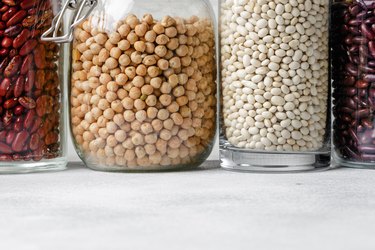
Like many people with diabetes, you're likely used to counting your daily carb intake — as well as your daily protein and fat intake — for balanced nutrition. But did you know that the marriage of two nutrients eaten together — protein and carbs — can help control your blood sugar?
At a high level, "There are three main macronutrients in nutrition: protein, fats, and carbohydrates," explains Joy Ashby Cornthwaite, RD, LD, diabetes care and education specialist at the University of Texas Health Science Center in Houston. "Eating a varied diet allows for a diversity of nutrients necessary for optimal body functions, including metabolism," she says. "Protein is important for muscle building and tissue repair, while carbohydrates are a primary energy source for the body."
Video of the Day
Video of the Day
Read more: A Healthy Diet Can Help Manage Type 2 Diabetes — These Are the Best and Worst Foods to Eat
Eat Protein With Carbs
More specifically, there are three reasons to nosh on carbs and proteins together.
First, protein is an essential part of the diabetes diet, and people with diabetes need about the same amount of daily protein as people without diabetes, so you need to include protein for balanced nutrition, according to the University of California at San Francisco (UCSF).
Secondly, you should include lean protein with your carbs because protein is digested more slowly than carbs, University of Wisconsin Health points out. Adding proteins slows down digestion, and that gives you a longer source of energy without the spike in blood sugar you get from carbs alone.
And the third reason: Pairing carbs with protein may make you eat fewer carbs. "People living with diabetes have found that lean proteins combined with other nutrients at mealtimes can lead to more sustained glucose ranges. Reasons may include reduction in the quantity of carbohydrate you consume at the same meal, due to satiety, which is a feeling of fullness or satisfaction," Ashby Cornthwaite says.
New Research
Some research suggests that protein may play a role in insulin secretion as well. In a small trial published in July 2017 in BMJ Open Diabetes Research & Care, a whey protein supplement given before a meal appeared to prevent a spike in blood sugar among people with type 2 diabetes compared to people who didn't take the whey protein pre-meal. However, in people who were overweight or had high blood fats, the insulin spike was worse.
The researchers note that more research is needed on the role of protein in blood sugar regulation.
A very small, July 2015 Diabetes Care study looked at what order foods are eaten. The preliminary research revealed an association with lower blood glucose levels when protein and veggies were eaten 15 minutes before carbs compared to when carbs were eaten first in people with type 2 diabetes.
Ashby Cornthwaite says detailed research in food pairing and ordering is lacking, but the way people with diabetes track glucose levels with technology today has begun to support recommendations for balancing protein with high-fiber carbs in meal planning.
Try These Tips
First, make sure you eat healthy proteins. UCSF recommends these steps:
- Avoid fatty meats (think sausage, bacon and ribs).
- Choose lean cuts of meat (poultry, fish; loin and round cuts).
- Trim fat off meat.
- Cook meat or fish by baking, broiling or roasting.
- Substitute vegetarian proteins for meat.
- Use nonfat or low-fat cheese and dairy foods.
The highest quality proteins for diabetes are plant proteins because of their healthy fats and fiber. American Diabetes Association (ADA) recommends beans and bean products, whole soy foods like edamame or tofu, and nuts. These can be paired with other whole food carb choices like fruits and veggies.
So, for a balanced snack, you might top an avocado with black beans, non-fat Greek yogurt, salsa and shredded cheese for 5 grams of protein and 12 grams of carbs, the nutrition experts at ADA's Diabetes Food Hub suggest.
For larger meals, the National Institute of Diabetes and Digestive and Kidney Diseases recommends using the plate method:
- Make half your plate a healthy carb like a green vegetable.
- Make one-fourth of your plate a lean protein.
- Make one-fourth of your plate a whole grain food or starchy vegetable like corn or peas.
- Add some fruit for dessert along with a glass of low-fat milk.
This way, you have the right balance between carbs and proteins.
Read more: 5 High-Protein, Plant-Based Recipes That Aren't Tofu
- University of California, San Francisco: “Understanding Protein”
- Joy Ashby Cornthwaite, MS RD LD CDE, certified diabetes educator, University of Texas Health Science Center, UT Physicians, Houston
- University of Wisconsin Health: “Nutrition Management of Low Blood Sugar Without Diabetes (Postprandial Syndrome and Reactive Hypoglycemia)”
- BMJ Open Diabetes Research & Care: “Glucose-Lowering Effect of Whey Protein Depends Upon Clinical Characteristics of Patients With Type 2 Diabetes”
- Diabetes Care: “Food Order Has a Significant Impact on Postprandial Glucose and Insulin Levels”
- American Diabetes Association: “Protein”
- American Diabetes Association Diabetes Food Hub: “4-Layer Stuffed Avocado”
- National Institute of Diabetes and Digestive and Kidney Diseases: “Diabetes Diet, Eating, & Physical Activity”